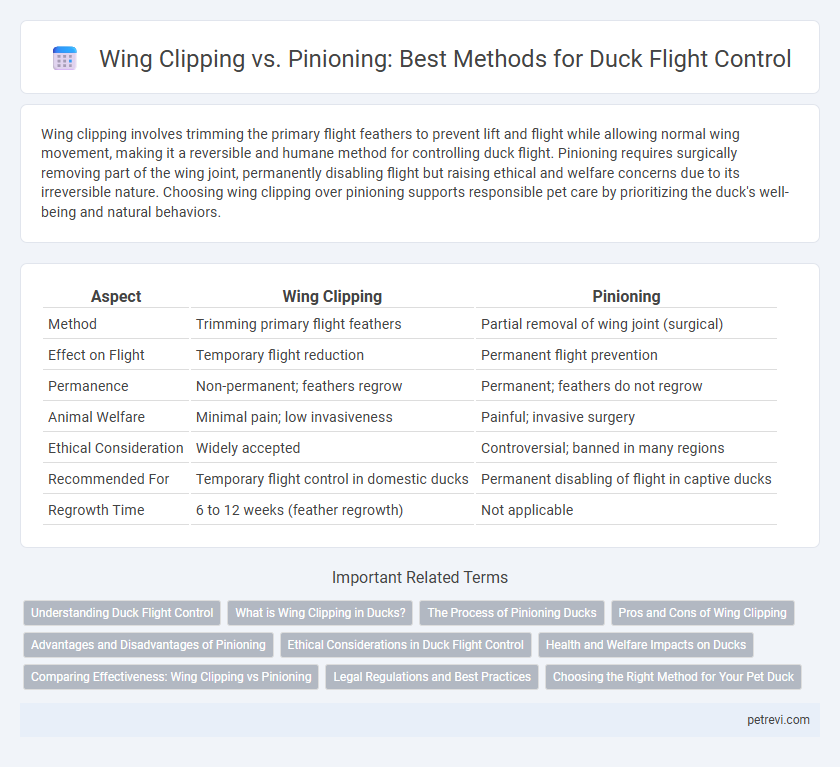Wing clipping involves trimming the primary flight feathers to prevent lift and flight while allowing normal wing movement, making it a reversible and humane method for controlling duck flight. Pinioning requires surgically removing part of the wing joint, permanently disabling flight but raising ethical and welfare concerns due to its irreversible nature. Choosing wing clipping over pinioning supports responsible pet care by prioritizing the duck's well-being and natural behaviors.
Table of Comparison
| Aspect | Wing Clipping | Pinioning |
|---|---|---|
| Method | Trimming primary flight feathers | Partial removal of wing joint (surgical) |
| Effect on Flight | Temporary flight reduction | Permanent flight prevention |
| Permanence | Non-permanent; feathers regrow | Permanent; feathers do not regrow |
| Animal Welfare | Minimal pain; low invasiveness | Painful; invasive surgery |
| Ethical Consideration | Widely accepted | Controversial; banned in many regions |
| Recommended For | Temporary flight control in domestic ducks | Permanent disabling of flight in captive ducks |
| Regrowth Time | 6 to 12 weeks (feather regrowth) | Not applicable |
Understanding Duck Flight Control
Wing clipping and pinioning are two common methods used to control duck flight by limiting wing mobility. Wing clipping involves trimming specific flight feathers to reduce lift without causing permanent damage, preserving the duck's ability to fly eventually. Pinioning surgically removes part of the wing joint, permanently preventing flight and ensuring more effective flight control but raises ethical concerns due to its irreversible nature.
What is Wing Clipping in Ducks?
Wing clipping in ducks involves trimming the primary flight feathers on one wing to prevent full flight without causing permanent injury. This method temporarily limits the duck's ability to fly while maintaining natural behavior and allows for feather regrowth. Compared to pinioning, which surgically removes part of the wing, wing clipping is a less invasive and reversible technique for flight control.
The Process of Pinioning Ducks
Pinioning ducks involves surgically removing the pinion joint, which permanently disables their ability to fly by preventing wing extension. This procedure requires precision to ensure minimal stress and proper healing, often performed under anesthesia to reduce pain and risk of infection. Unlike wing clipping, pinioning is irreversible and typically carried out on young ducklings before their feathers mature.
Pros and Cons of Wing Clipping
Wing clipping in ducks involves trimming the primary flight feathers to limit flight ability, reducing the risk of escape and injury while preserving balance and natural behaviors. It is a reversible and less invasive method compared to pinioning, which surgically removes part of the wing but causes permanent flightlessness and pain. However, wing clipping requires regular maintenance as feathers regrow and may reduce a duck's ability to escape predators in outdoor environments.
Advantages and Disadvantages of Pinioning
Pinioning permanently disables a duck's ability to fly by surgically removing a portion of the wing joint, preventing flight and reducing escape risks in outdoor environments. This method offers a long-term solution with no need for repeated maintenance, unlike wing clipping which requires regular trims to remain effective. However, pinioning is an irreversible procedure that raises ethical concerns due to its invasive nature and potential for post-surgical pain or complications.
Ethical Considerations in Duck Flight Control
Wing clipping and pinioning are common methods used to control duck flight, but ethical considerations heavily favor wing clipping due to its reversibility and lower impact on the bird's well-being. Pinioning involves surgically removing part of the wing permanently, causing irreversible harm and raising significant animal welfare concerns. Choosing wing clipping aligns with more humane practices, allowing ducks to retain natural behaviors while preventing escape or injury.
Health and Welfare Impacts on Ducks
Wing clipping involves trimming the primary flight feathers, which temporarily limits flight without causing permanent harm, allowing ducks to maintain normal wing function and feather regrowth. Pinioning, the surgical removal of a wing joint, permanently incapacitates flight but raises significant welfare concerns due to pain, irreversible loss of natural behavior, and potential complications. Health impacts of wing clipping are minimal and reversible, whereas pinioning poses long-term physical and psychological stress, making wing clipping the more humane option for flight control in ducks.
Comparing Effectiveness: Wing Clipping vs Pinioning
Wing clipping limits a duck's ability to generate lift by trimming primary flight feathers, reducing flight distance and height while maintaining some feather regrowth each molt; pinioning involves surgically removing part of the wing's bone, resulting in permanent flightlessness without feather regrowth. Wing clipping is less invasive and reversible but requires regular maintenance to remain effective, whereas pinioning is irreversible and considered more effective at completely preventing flight. Both methods significantly inhibit flight, but pinioning guarantees permanent control, while wing clipping offers a temporary, adjustable option.
Legal Regulations and Best Practices
Wing clipping is a commonly accepted method for flight control in ducks and is legal in many regions due to its non-invasive nature and minimal long-term impact. Pinioning, involving the surgical removal of wing parts, is often restricted or banned under animal welfare laws in countries like the UK, Australia, and several EU states, as it causes permanent harm. Best practices emphasize regular wing clipping by trained individuals to ensure duck mobility and safety while complying with local animal protection regulations.
Choosing the Right Method for Your Pet Duck
Wing clipping involves trimming the flight feathers on one wing to prevent flight while maintaining natural wing function and comfort, making it a less invasive option for pet ducks. Pinioning surgically removes part of the wing joint to permanently inhibit flight but raises ethical concerns and requires veterinary expertise. Choosing between wing clipping and pinioning depends on factors such as the duck's age, health, intended environment, and owner preference for reversibility and animal welfare.
Wing clipping vs Pinioning for Duck flight control Infographic

 petrevi.com
petrevi.com